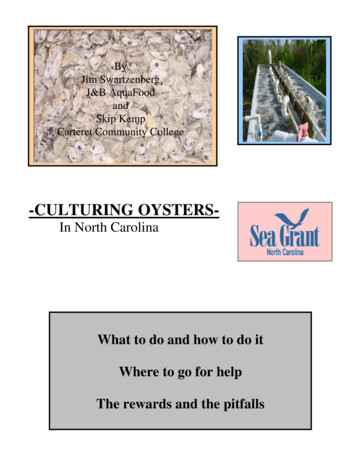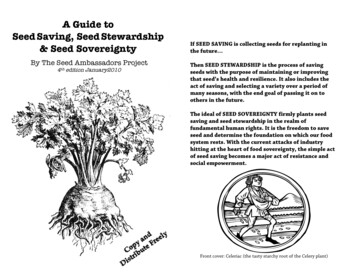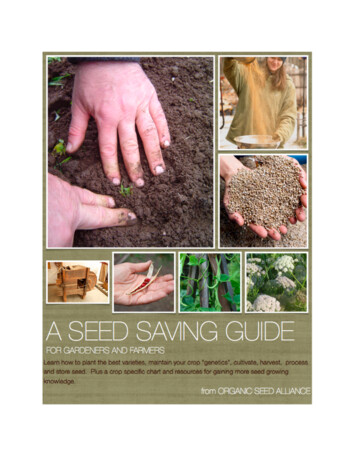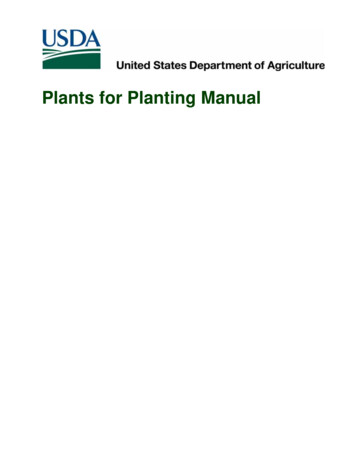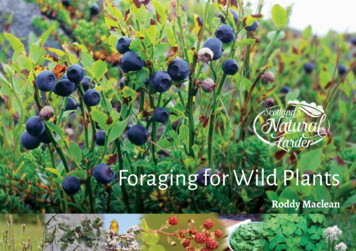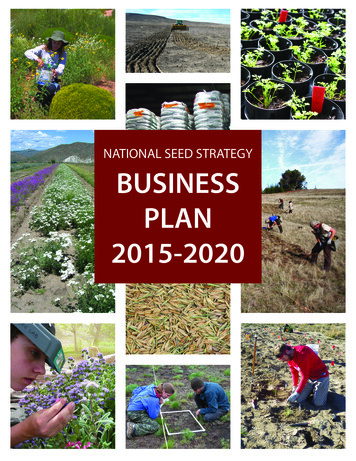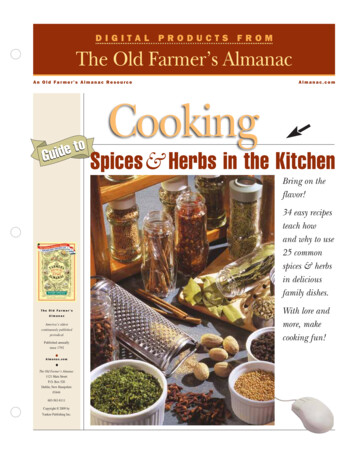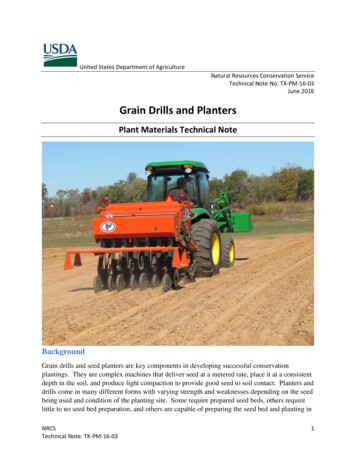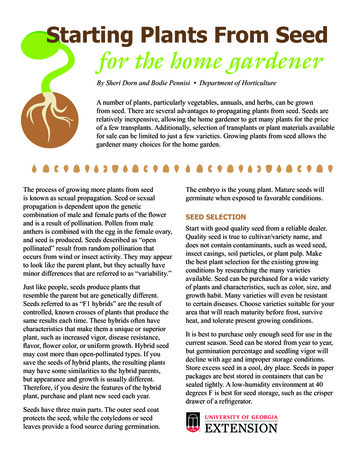
Transcription
Starting Plants From Seedfor the home gardenerBy Sheri Dorn and Bodie Pennisi Department of HorticultureA number of plants, particularly vegetables, annuals, and herbs, can be grownfrom seed. There are several advantages to propagating plants from seed. Seeds arerelatively inexpensive, allowing the home gardener to get many plants for the priceof a few transplants. Additionally, selection of transplants or plant materials availablefor sale can be limited to just a few varieties. Growing plants from seed allows thegardener many choices for the home garden.The process of growing more plants from seedis known as sexual propagation. Seed or sexualpropagation is dependent upon the geneticcombination of male and female parts of the flowerand is a result of pollination. Pollen from maleanthers is combined with the egg in the female ovary,and seed is produced. Seeds described as “openpollinated” result from random pollination thatoccurs from wind or insect activity. They may appearto look like the parent plant, but they actually haveminor differences that are referred to as “variability.”Just like people, seeds produce plants thatresemble the parent but are genetically different.Seeds referred to as “F1 hybrids” are the result ofcontrolled, known crosses of plants that produce thesame results each time. These hybrids often havecharacteristics that make them a unique or superiorplant, such as increased vigor, disease resistance,flavor, flower color, or uniform growth. Hybrid seedmay cost more than open-pollinated types. If yousave the seeds of hybrid plants, the resulting plantsmay have some similarities to the hybrid parents,but appearance and growth is usually different.Therefore, if you desire the features of the hybridplant, purchase and plant new seed each year.Seeds have three main parts. The outer seed coatprotects the seed, while the cotyledons or seedleaves provide a food source during germination.The embryo is the young plant. Mature seeds willgerminate when exposed to favorable conditions.SEED SELECTIONStart with good quality seed from a reliable dealer.Quality seed is true to cultivar/variety name, anddoes not contain contaminants, such as weed seed,insect casings, soil particles, or plant pulp. Makethe best plant selection for the existing growingconditions by researching the many varietiesavailable. Seed can be purchased for a wide varietyof plants and characteristics, such as color, size, andgrowth habit. Many varieties will even be resistantto certain diseases. Choose varieties suitable for yourarea that will reach maturity before frost, surviveheat, and tolerate present growing conditions.It is best to purchase only enough seed for use in thecurrent season. Seed can be stored from year to year,but germination percentage and seedling vigor willdecline with age and improper storage conditions.Store excess seed in a cool, dry place. Seeds in paperpackages are best stored in containers that can besealed tightly. A low-humidity environment at 40degrees F is best for seed storage, such as the crisperdrawer of a refrigerator.
Bodie PennisiSome seed can be purchased in treated form. One type of treatment isa fungicide coating, which increases the seed’s chance for survival byprotecting it from disease organisms in the soil (Figure 1). Small seed maycome in a pelleted form, with a coating of clay or other inert material thatmakes the seeds easier to sow by hand and get a more uniform standwith fewer plants to thin (Figure 2). Legume seed can be treatedwith nitrogen-fixing bacteria, which help plants draw nitrogenfrom the air and deposit it in their roots. Similar to hybridseed, treated seed is also more costly, but can be worththe extra expense.Figure 2. Pelleted seed is easier to sow uniformly.Figure 1. Fungicide-treated seed.READING A SEED PACKAGECommercial seed packages include a lot ofhelpful information. Look for the year the seedswere packed, usually printed or stamped on theenvelope (will appear as “sell by” or “grown for”).Look for seeds packed for the current season.Additionally, the packet typically indicates howfar apart to space seeds within a row, the depthfor sowing the seeds, days to germination, andinstructions for thinning seedlings. Seed packagescan be retained as part of garden records for futurereference (Figure 3a and 3b).Figure 3a. Example of typical seed package.UGA Extension B 1432 Starting Plants from Seed for the Home GardenerFigure 3b. Example of typical seed packages.2
GERMINATIONGermination is the process of the embryoemerging from the seed. It starts with imbibition,or the absorption of water. Germination is heavilyinfluenced by four environmental factors, includingwater, oxygen, light, and temperature.WaterWater is critical for the first step in germination.Without water, seeds will remain dormant. Theamount of water is critical; too much water causesseeds to rot, and too little water causes embryos todie. Adequate, continuous moisture is essential togermination. Misting seeds with a mist nozzle or ahand-held spray bottle provides light, even, gentlemoisture without disrupting seeds. Covering seedswith a thin layer of vermiculite or peat moss helpsensure good seed-to-media contact and helps preventthe embryo from drying out. Keep the humidity higharound germinating seeds by covering pots or flatswith a clear humidity dome or enclosing plants inclear plastic bags. Remove plastic bags as the seedsgerminate and seedlings emerge.OxygenViable (live) seeds actively respire, releasing carbondioxide and consuming oxygen. As germinationproceeds, respiration increases and more oxygenis needed. Seed-starting media needs to drain wellenough to meet this need for oxygen. If the media(i.e., garden soil) is too heavy or too wet, seeds willnot have the oxygen they require, and germinationmay be greatly slowed or stopped (death).germination. A good rule of thumb is 65 to 75 degreesF for germinating most seeds.To monitor soil or media temperature, use athermometer with its probe in the middle of thecontainer or flat. To raise temperature, use moistureproof heating mats or cables under flats or containers(following manufacturer’s instructions). Alternately,flats can be placed in warm spots in the home, suchas near a radiator, for the germination process. Thenmove the seedlings to a bright location so theycan continue to develop. Monitor temperature andmoisture so that embryos and seedlings remain viable.After germination, temperature should be graduallylowered to 65 degrees F.MATERIALSMediaChoose a sterile, soilless potting media withoutfertilizer to start seeds. Sterile mixes are free of weedseeds and disease organisms. Weeds compete withthe germinating seedlings for water and nutrients,and disease organisms can kill seedlings in the earlystages of germination. Avoid using garden soil as it isheavy, holds a tremendous amount of water, and oftencontains weed seeds or disease. A good seed-startingmedia will have a fine, even texture and be fairlyuniform. This will help maintain good contact of seedwith media. You do not want a seed-starting mediathat is lumpy or chunky, especially when sowingsmall seeds (Figure 4).LightSome seeds require light to germinate, while othersrequire darkness. Some seeds have no preference atall. Look in catalogs and seed packets for specificinformation for the seeds being grown. If a seedrequires light for germination, sow the seeds on thesoil surface. If a seed requires darkness, cover itlightly with a layer of fine peat moss or vermiculite.Figure 4. Seed-starting media (left)versus growing media (right).TemperatureTemperature affects the number of seeds thatgerminate as well as how fast the seeds germinate.Some seeds have a very specific temperature rangefor germination, while others will germinate overa broad range of temperatures. Seed packets andcatalogs generally list the optimum temperature forThere are several sterile, soilless materials fromwhich to choose. Sand, perlite, vermiculite, and peatmoss are readily available and can be mixed togetherto create a media that has good moisture-holdingcapacity and good drainage. Sphagnum peat mossis often combined with perlite for a seed-startingUGA Extension B 1432 Starting Plants from Seed for the Home Gardener3
media. A good recipe for making your own media includes 4 quarts shredded sphagnum peat moss, 4 quarts finevermiculite, 1 tablespoons of superphosphate, and 2 tablespoons of ground limestone. Mix thoroughly, then wetcompletely. Leave the soil to drain and do not plant for 5 to 6 days. This allows the lime to react with the peatmoss and create a favorable environment for the seedlings.ContainersAny container can be used for starting seeds as long as it drains, is deep enough for good root development,and is sanitized prior to use (Figures 5a, 5b, and 5c). Plastic inserts, flats, and trays are available for purchase.Rectangular flats and trays are usually 12 to 18 inches long and often come with a clear, fitted dome or cover.You can make your own flats from wood, but they are heavier than plastic flats and are more difficult to sanitizefor reuse. Be sure to leave gaps between the slats, or drill holes in the bottom, for drainage. You can fill theflat directly with media, or use an insert or smaller container set into the flat and filled with media. Growingseedlings in individual cells or containers reduces damage to roots and shock to the seedling when latertransplanted into the garden or another container.Figure 5a. Hydrated peat pelletsin a flat with humidity dome.Figure 5b. Recycled plasticsandwich box.Figure 5c. Fiber Pots.You can also make your own containers from recycled materials, such as plastic salad boxes and muffincontainers, as long as good drainage is provided and there is adequate depth for root development. The clearplastic containers are like mini greenhouses. When the lids are closed, anideal high-humidity environment is created for germinating seeds. Asthe seedlings emerge and grow, the lid can be gradually opened andremoved. Pots can also be made from recycled newspaper using acan or bottle as a form, or soil blocks can be made with an initialinvestment in a molding device.Additionally, seeds can be started in hydrated peat pellets foreasy transplant into the garden (Figure 6).Sanitation is critical in the germination process. Diseasecausing fungi can attack seedlings and kill them at this earlystage. To reduce chance of fungal attack, use sterile mediaand sanitized containers. To sanitize used containers, wash toremove any soil or debris and rinse with a solution of one partchlorine bleach to nine parts water. Rinse thoroughly with cleanwater.LocationProviding appropriate air and media temperatures as wellas adequate moisture and humidity is important to seedUGA Extension B 1432 Starting Plants from Seed for the Home GardenerFigure 6. Plant growing in a peat pellet.4
germination. Choose a warm location that providesbright, indirect light and good air circulation. Forbest results, refer to the information on temperaturepreviously mentioned in the section on germination.SEEDING TECHNIQUESSeeds can be sown directly into the container or spacewhere they will grow, or they can be transplanted toanother container or space to finish growing. Mostseeds are planted at a depth approximately twice theirdiameter. Very small seeds should be simply pressedgently into the surface of the soil and barely covered.To raise the humidity for the germinating seeds,the container can be covered with plastic wrap orplaced in a plastic bag, but remove the bag as soon asgermination occurs.TransplantingSome seeds are started in a seed bed, transplanted to asecondary container for growth and development, andthen transplanted to the container or place where theywill grow and finish their life cycle. For example,tomatoes are germinated, transplanted to a flat, grownout for several weeks, and then planted in the gardenafter last frost. A seed bed may be a small containerof seed-starting media, a flat filled with media, or aprepared bed in the garden (though seedlings are atgreater risk for insect and disease attack). Seeds canbe scattered across the top of the media or sown inrows (Figure 7).Once seeds germinate, you will need to providesupplemental light for proper seedling growth.Light stands should position the lights within 2 to3 inches of the seedlings. As the seedlings grow,raise the lights, but keep them 2 to 3 inches abovethe seedlings. Set a timer so that the lights are on 16hours daily. As seedlings grow, raise the lights abovethe plants. Without supplemental light, plants will beweak and spindly, often stretching toward a windowor other light source.Direct SeedingNot all plants respond well to transplanting, and forsome crops, such as beans, transplanting does notoffer benefit enough to pursue. Most large-seededplants, such as corn and pumpkin, and root crops,such as carrots and beets, are best direct-seeded.Sow seeds directly into the container or place wherethey will grow, following the recommended seedingdepth on the package. Species with small seeds canbe more challenging to handle. Carefully prepare theseed bed so that it is smooth and even, and pay closeattention during germination and initial growth of theseedlings.Seeds that can be direct sown:Lima BeansSunflowerCarrotOakGreen BeansBeetCornDillFigure 7. Seeds germinating in seed beds forfuture transplant.Managing moisture during germination and at theseedling stage can be challenging. You want to keepthe media moist so that the embryo does not dryout, but you do not want to overwater. Media that istoo wet will cause seeds to rot or seedlings to die.Remember to keep seed-starting media moist tothe touch.While it sounds like a bit of extra work, there areseveral benefits to germinating seeds in preparationfor transplanting. Ultimately, you will end up withthe desired number of plants, as opposed to havingtoo few or too many. By germinating in a seed bedand transplanting to the desired flat or container,you do not waste valuable space in your propagationarea with containers where seed has not germinated.If you are working with seed whose viability isUGA Extension B 1432 Starting Plants from Seed for the Home Gardener5
declining, you can sow extra seed in a seed bed andtransplant what actually germinates and is vigorous.This also gives you an indication of when the seedare no longer viable and ready for discard. Growingtransplants allows you to make the most of thegrowing season by having plants ready at the besttime for planting outdoors.Plants that benefit from nsyAlyssumTIMINGIf you are sowing seeds to grow transplants, timing isan important consideration. You want the transplantsto be ready for planting in the garden when soiltemperatures are appropriate and threat of frost haspast. If seeds are started too early, seedlings may beready for transplant before they can safely be plantedoutdoors. When timed properly, warm-season plants(i.e., tomatoes, squash, zinnias, and marigolds) areready to plant outside in the spring garden by thetime of last frost. Cool-season plants (i.e., pansies,broccoli, cabbage, and snapdragons) for fall gardensshould be planted with enough time to establish andproduce before the first frost. Generally, sow seeds 6to 8 weeks prior to transplant time. For example, ifyour average last frost date is April 15, sow tomatoseeds inside in late-February/early March. For moreinformation, refer to the vegetable planting chart inVegetable Gardening in Georgia (UGA Extensioncircular 963).on the seed packet. Weak or unwanted seedlings canbe snipped off with scissors or pinched off at themedia level.TRANSPLANTING SEEDLINGSAfter germination and the development of the firsttrue leaves, the seedlings can be transplanted to acontainer of choice. Use a pencil or dibble tool toprobe under seedling roots and lift gently (Figure 8).Use the same pencil or dibble to create a hole for theseedling in the new container or location. Seedlingsshould be set at approximately the same depth theywere growing in the seedling flat or pot. Avoidplanting too deep or too shallow. Never tug seedlingsout of a seed bed or transplant container by grabbingthe stem. This can result in a crimped stem, whichwill result in seedling death.Figure 8. Transplanting seedlings.When ready to be transferred to the garden, the smallplants will have several sets of leaves and a sturdyroot system (Figure 9).THINNING SEEDLINGSGardeners generally sow more seeds than are desiredas a precaution to ensure that the right number ofplants is ultimately grown. Especially with tiny seeds,such as pansy or carrot, lots of seeds can end up in asmall space. Regardless, seedlings need to be thinned,leaving the remaining plants with enough spacebetween them to grow and develop properly. Eventhough it can be difficult to remove excess seedlings,crowded plants — plants that are not thinned — areat risk for death from competition for water, light, andnutrients. The spacing information can often be foundFigure 9. A transplant ready to go in the garden.UGA Extension B 1432 Starting Plants from Seed for the Home Gardener6
After transplanting, water the plants thoroughly but gently. Seedlings can dry out quickly so check them daily,especially if they are on a heat mat or heat cables or under lights. Seedlings dry out faster with additional heat.The first few weeks are most critical because root systems are small and developing.Begin fertilizing transplants with soluble fertilizer according to label directions for new transplants. Becausenew seedlings are easily damaged by excess fertilizer, initial applications are often half of the regular rate.Repeat at two-week intervals after transplanting. Never fertilize plants that show signs of moisture stress, suchas wilted or gray-green leaves.HARDENING OFFPlants raised in a high humidity, sheltered location need to be prepared prior to planting in drier, harsherconditions, such as outside in the garden. This preparation process is referred to as “hardening off.” One wayto prepare plants is to move them outside to a shady location, gradually increasing the amount of sunlightover a period of several days. You can also choose an overcast day to first take the plants outside, bringing theplants back inside after a few hours. Repeat daily, extending the length of time that plants remain outside byan hour, until the plants have acclimated to the brighter, drier outdoor conditions. This transition can also beaccomplished by reducing temperatures (to between 45 and 50 degrees F) and reducing water.The idea is to slow growth and thicken plant cell walls. Start this process one to two weeks prior to plantingseedlings in the garden. Take care to transition plants gradually as extreme changes can slow growth to the pointof plant death.SAVING SEEDYou may want to save seed from your garden plant. These seeds are the result of random pollination and willmost likely not produce plants identical to the parents, particularly with hybrid varieties. Be sure that seedcollected from the garden is mature and totally dry before storing. Seeds stored with extra plant pulp or plantmaterial that is not completely dry may mold and deteriorate while in storage. Collected seeds usually have a65-80 percent germination rate, and three-quarters of those seedlings will produce satisfactory plants.UGA Extension B 1432 Starting Plants from Seed for the Home Gardener7
UGA Extension B 1432 Starting Plants from Seed for the Home Gardener8
Directionsfor Starting Seeds1. Select a container, making sure that it is sanitized,will drain, and is deep enough for root growth anddevelopment.2. Fill the container with moistened, sterile, seedstarting mix and firm the surface.3. Check seed package for planting depth.4. Make shallow indentations in themedia and sow the seed evenly.5. Lightly water the surface, and placethe container in a warm area (not indirect sunlight).6. As seeds germinate, move seedlingsto a well-lit area, such as underfluorescent lights.7. The cotyledons, or seed leaves willemerge first.
8. When two or three true leavesemerge, transplant seedlingsinto flats or small pots filledwith moist potting soil. Keepsoil evenly moist.9. Allow plants to grow several more sets oftrue leaves. Keep lights 2 to 3 inches aboveseedlings, adjusting as necessary.10. When plants have reached desired size,prepare them for planting in the garden by“hardening off.”11. Water the transplants well initially and forseveral weeks after planting.extension.uga.eduBulletin 1432Reviewed February 2018Published by the University of Georgia in cooperation with Fort Valley State University, the U.S. Department of Agriculture, and counties of the state. For more information, contact your local UGA Cooperative Extension office.The University of Georgia College of Agricultural and Environmental Sciences (working cooperatively with Fort Valley State University, the U.S. Department of Agriculture, and the counties of Georgia) offers its educational programs,assistance, and materials to all people without regard to race, color, religion, sex, national origin, disability, gender identity, sexual orientation or protected veteran status and is an Equal Opportunity, Affirmative Action organization.
a fungicide coating, which increases the seed’s chance for survival by protecting it from disease organisms in the soil (Figure 1). Small seed may come in a pelleted form, with a coating of clay or other inert material that makes the seeds easier to sow by hand and get a
